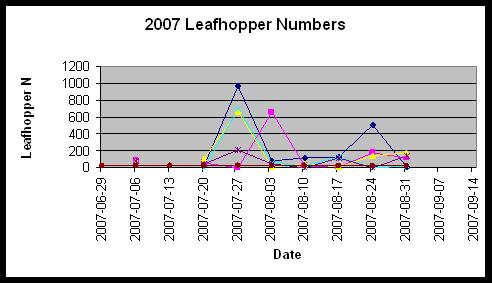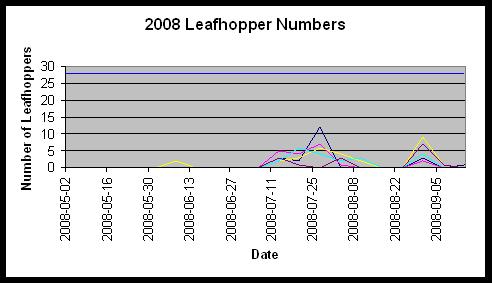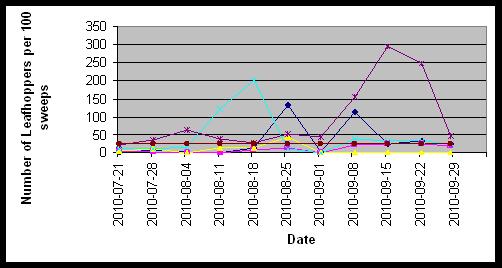The Aster Leafhopper - Why Carrots Matter if you are Growing Canola
Many people have not forgotten the late summer of 2007. During swathing of canola strange sights appeared in many fields – canola stems standing upright with misshapen pods while much of the canola hung heavy in the field. Some of the foliage was perhaps a little purple? What was going on with those stems and what caused it? Most have since learned that the upright and funny looking pods were a sign of infection by the aster yellows phytoplasma (it’s not a virus) and it was transmitted to the plants by the aster or six-spotted leafhopper.
During the winter extension season of 2007-08 there was much talk about what had happened and why. Now three years later there is still concern that aster leafhopper is a major issue in canola. So the question to address is whether it is currently a serious consideration for canola growers or perhaps just something that is occasionally a problem.
Now two paragraphs into the article you’re still left wondering why carrots are mentioned. The reason carrots relate to canola is because of a simple value calculation: carrots are worth a lot more, per acre, than canola. As a result of this, carrots are regularly monitored for populations of aster leafhopper because they are a serious problem every year in that crop. Now for most Manitoba farmers this is largely irrelevant (it is critical for those that grow carrots commercially) but can provide some very useful information. So let’s talk about some basic information before we go back to talking about canola.
The aster leafhopper (Macrosteles quadrilineatus) or six spotted leafhopper is a small, pale green insect with six marks on its “forehead”. It is only about 2-3 mm in length and is very difficult to see in fields without a hand magnifier. It spends the winter months in the Gulf States before moving north with the aid of winds out of the south. Typically it arrives in larger numbers in Manitoba towards the end of June with some arriving as much as six weeks earlier. There may be a small portion of the population that overwinters in Manitoba but this is insignificant in terms of contributions to the overall population. Why do we say that? Look below at the graph of the leafhoppers from 2007:

The red line down at the bottom of the graph corresponding to 25 leafhoppers is the economic threshold in carrots (the economic threshold is related to the number of leafhoppers collected in 100 sweeps in a carrot field). Obviously we surpassed that number by tremendous amounts. There was quite simply very large numbers of leafhoppers present in 2007, not only in carrot fields, but just about all crops. Now, logically speaking if aster leafhopper overwinters in Manitoba successfully and we had extremely large numbers in 2007 we should have seen large numbers of leafhoppers in 2008, correct? Well, look at the following graph:

Look at the scale on the side of this graph and compare it to the 2007 graph. This time the blue line represents the economic threshold and while it is slightly higher than in 2007 (this is a reflection of the relative level of infectivity in the leafhopper which will be explained below) it isn’t particularly important. What is important is that you can see that the leafhopper numbers were incredibly low in 2008 versus 2007. Were we having large numbers of leafhoppers overwinter in Manitoba we’d have seen much higher populations in 2008. In the spring of 2008, during the usual migration period of the leafhoppers there were tremendous rains throughout the American Midwest that essentially stopped the migration of leafhoppers. What appears in the graph above is likely a result of very small arrival of migratory leafhoppers combined with whatever small amount of leafhoppers manage to overwinter here.
So we can reasonably suggest that the leafhoppers that cause problems here are primarily a result of migratory populations carried in on winds. The number of leafhoppers that arrive is only a part of the equation. The other critical point is how much of the phytoplasma (or disease) they are carrying. In most years it is estimated that 2-4% of the leafhopper population is infected with the aster yellows phytoplasma. When discussing carrots there is an index that has been developed to make use of this information and it is called the ‘Aster Yellows Index’ (AYI). The AYI is calculated by sampling leafhoppers in carrot fields. One hundred sweeps in a semi-circle (180°) are made in random parts of the field and the number of leafhoppers collected in those 100 sweeps is counted. This number is then multiplied by the level of infectivity, which is usually an estimate. So by example if you collect fifty leafhoppers in one hundred sweeps and the infectivity is four percent then:
50 x 4 = 200
In carrots the economic threshold is an AYI of one hundred. If an AYI of 200 was our result, then a grower would likely initiate a spray. If the infectivity was only one percent, then the AYI value would only be 50 (50 x 1) and no action would be taken.
So whether leafhoppers are a concern is a combination of the number of leafhoppers AND the proportion of the leafhoppers that are carrying the phytoplasma. Carrots provide information to canola growers because they function as a sentinel crop, a plant that is far more sensitive to aster yellows, and can act as an early warning if the information is looked at.
Let’s now take a look at 2010 data for the aster leafhopper in carrot fields:

The economic threshold is again set at 25 and represented by the red line. In the graph above you can see that several times in several locations the economic threshold (for carrots) was exceeded. Was this an issue for carrots? To be certain yes it was. But think now about the canola crop this year. Did you see what you saw back in 2007? Were there stems standing up and deformed pods that could be attributed to aster yellows infection? Perhaps there was some in isolated locations but for the most part reports indicate that it was not an economic problem this year. Yet the numbers in the graph above, while not as high as those in 2007 were still considerable, the highest point yielding an AYI value of about 1200 or twelve times the economic threshold.
What does this mean for the relationship between aster leafhopper and canola? To a certain degree it indicates that aster leafhopper and aster yellows are relatively rarely a problem in canola (one or two years out of every ten). Even with somewhat high populations (as estimated by populations in carrots) and a reasonable amount of infectivity that caused problems in carrots there is no problem of economic scale in canola. It is reasonable to suggest that in most years aster yellows is not of economic concern in canola but carrot scouting can at least provide an early warning of problems that may be brewing for canola.

